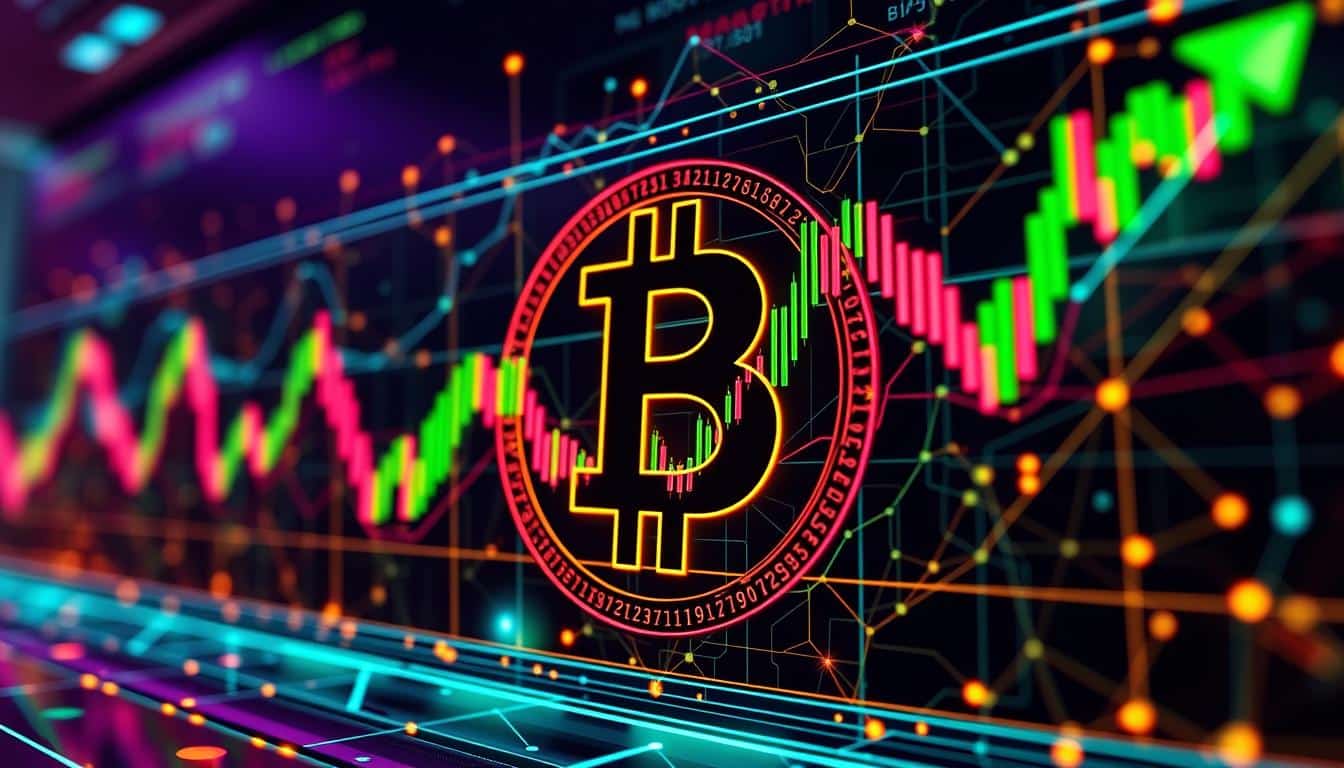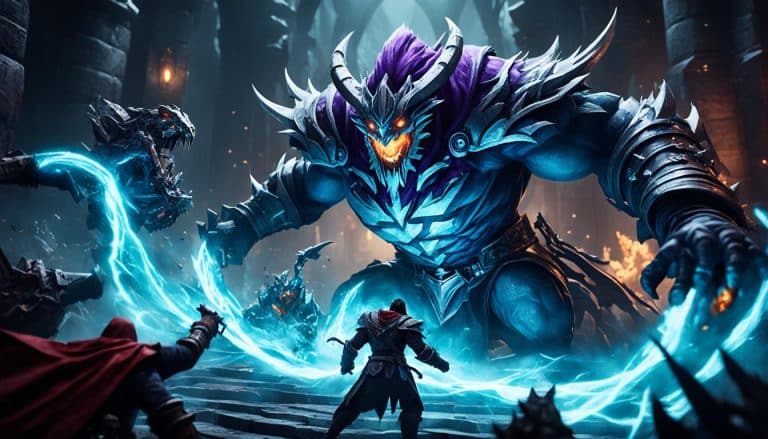Uncover BTC Halving Chart Patterns & Predictions
Did you know that from 2020 to 2022, the US saw an 80% rise in total dollars in circulation1? This spike raised concerns about inflation. Unlike traditional money, Bitcoin has a cap of 21 million coins, with predictions of reaching this by 21401. This limited supply makes Bitcoin halving events crucial in the crypto market.
The next Bitcoin halving on April 19, 2024, is more than just a date. It’s a major event that changes Bitcoin’s value and its place in the market. Historically, each halving has led to a price surge within 180 days, highlighting Bitcoin’s rarity2.
Statistics back this up. After the 2012 halving, Bitcoin’s price soared from $12 to over $200. Following the 2016 halving, the price jumped from around $650 to an incredible $19,7001. With the 2024 halving approaching, the industry is buzzing about its potential effects and what btc halving chart patterns may reveal.
The halving slashes miners’ block rewards by 50%, similar to how scarce resources like gold are managed. This shift fundamentally alters Bitcoin’s supply rules2, cementing its place in a deflationary system.
To dive deeper, cryptocurrency market analysis can illuminate past trends and future forecasts. Using these insights for your investment approach could be crucial as we move into 2024 and beyond.
Key Takeaways
- Bitcoin’s next halving event is expected to occur on April 19, 2024.
- The total supply of Bitcoin is capped at 21 million, enhancing its scarcity1.
- Past halvings have sparked significant price increases within 180 days2.
- Each halving cuts the block reward for Bitcoin miners by 50%2.
- The 2024 halving is expected to reduce the block reward to 3.125 BTC2.
- Bitcoin halving events are key drivers in Bitcoin’s deflationary structure.
The Bitcoin Halving Cycle Explained
The bitcoin halving cycle significantly impacts Bitcoin’s economic policy and market actions. It happens roughly every four years. Each new halving changes how Bitcoin’s supply and demand interact.
What is Bitcoin Halving?
Bitcoin halving cuts the mining reward by half. This was planned by Bitcoin’s creator, Satoshi Nakamoto. It happens after 210,000 blocks, or about every four years3. The next halving, expected in April 2024 at block 740,000, will lower the reward to 3.125 BTC from 6.254. This step from the original 50 BTC shows its importance in managing Bitcoin’s supply3
Historical Context of Halvings
The first Bitcoin halving was on November 28, 2012. It decreased the block reward to 25 BTC3. The second, on July 9, 2016, lowered it to 12.5 BTC3. The third, May 11, 2020, brought it down to 6.25 BTC3. After each halving, Bitcoin’s price surged significantly.
For example, after the 2020 halving, its price jumped from about $8,000 to over $69,000 by April 20213.
Impacts on Bitcoin’s Scarcity
The halving cycle boosts Bitcoin’s rarity, making it a currency that fights inflation. By cutting the number of Bitcoins entering circulation, each halving makes the cryptocurrency rarer. This can increase demand and drive up prices. By May 2024, around 19.7 million bitcoins were circulating, leaving about 1.3 million to be mined until the last one around 21405. This gradual cutback serves as a safeguard, keeping Bitcoin valuable like gold5.
Bitcoin’s capped supply of 21 million coins, to be fully mined by 2140, turns it into a deflationary currency4. The decrease in block rewards promotes long-term investment and saving. This helps maintain value amid a decreasing supply.
A History of Bitcoin Halvings
Bitcoin’s history features three key halving events. These milestones changed block rewards and market actions. They also heightened Bitcoin’s value.
The First Bitcoin Halving (2012)
The inaugural Bitcoin halving was on November 28, 2012. It slashed the block reward from 50 BTC to 25 BTC67. Back then, Bitcoin’s price was about $13. Yet, it rocketed to $1,152 the next year6. This surge post-halving proved the reduced supply would lift Bitcoin’s market price7.
The Second Bitcoin Halving (2016)
On July 9, 2016, the block reward was cut again to 12.5 BTC during the second halving78. Bitcoin was valued at $664 at this event. Then it soared to $17,760 by the following year6. This halving highlighted Bitcoin’s rarity, boosting its market worth and confirming its investment potential8.
The Third Bitcoin Halving (2020)
The third halving happened on May 11, 2020, dropping the reward to 6.25 BTC78. Bitcoin stood at $9,734 but jumped to $67,549 the next year, showing a strong halving effect6. Amidst economic challenges, this cycle showed Bitcoin’s strength and growth potential, preserving trust from the public and investors8.
| Date | Block Reward | Price at Halving | Peak Price Next Year |
|---|---|---|---|
| November 28, 2012 | 25 BTC | $13 | $1,152 |
| July 9, 2016 | 12.5 BTC | $664 | $17,760 |
| May 11, 2020 | 6.25 BTC | $9,734 | $67,549 |
The 2024 Bitcoin Halving: What to Expect
The 2024 Bitcoin halving is a big deal for those into cryptocurrency. It’s set for April 2024 and will cut the block rewards from 6.25 to 3.125 bitcoins. This follows the pattern of halvings happening every four years910.
Projected Changes to Block Rewards
The block reward will drop from 6.25 to 3.125 bitcoins in the next halving. This fits Bitcoin’s plan to halve rewards every 210,000 blocks until 21 million bitcoins are out there9. With lower rewards, mining becomes less profitable unless Bitcoin’s value goes up. This will hit smaller mining outfits the hardest9.
Market Speculations and Forecasts
Experts think Bitcoin’s value will jump after the 2024 halving. Past halvings have led to major price increases within a year. For example, after the 2012 halving, Bitcoin’s price went from $12.35 to $127.00 in 150 days9.
The 2016 halving pushed prices from $650 to nearly $19,000 by the end of 201710. And the 2020 halving saw prices soar from around $9,000 to almost $70,00010. These trends have investors excited about the next halving’s impact910.
Bitcoin Halving Impact on Miners & Market
The Bitcoin halving is a big deal for miners and the market. It happens every four years, cutting miner block rewards by half. This shift can seriously affect miner profits as their costs go up and profits shrink11. To keep making money, miners need to find ways to work more efficiently.
Miner Revenue Adjustments
After a halving, miner earnings drop from 6.25 to 3.125 BTC12. This sparks more competition and might lead to fewer, larger miners11. Over time, the cost of mining tends to rise, shown by the network’s changing hash rate11.
Market Reactions to Reduced Supply
How the market reacts to Bitcoin halving can shift its price. Before the last halving, Bitcoin’s price dipped by about 4%. However, it soared afterward: rising 93 times in 2012, 30 times in 2016, and 8 times in 202012. This pattern points to Bitcoin’s strong growth outlook thanks to its increasing rarity11.
Even with potential dips, the overall market view is upbeat. These events usually boost trading and market action1112.
Analyzing Bitcoin Block Reward Reductions
Understanding bitcoin mining is key as halving events change the game for miners. Rewards decrease over time, pushing miners to adapt and innovate for profit.
Technological Advancements in Mining Equipment
Mining technology has greatly evolved. Each halving spurs the need for better, more efficient equipment. For example, the First Halving in 2012 cut rewards from 50 to 25 bitcoins, making miners upgrade their gear as the network’s hash rate fell13. The Third Halving in 2020 saw a cut to 6.25 bitcoins, pushing miners towards high-tech machinery13.
Profitability Metrics Analysis
Profitability metrics for miners change with reward reductions and costs. After halvings, prices usually go up. The First Halving boosted the price from $13 to $1,152 in a year. The Second Halving pushed it to $17,760 from $66413. This price increase is vital for analyzing mining profitability, giving efficient miners a bigger market share. After halvings, the bitcoin issuance rate will drop from 900 to 450 BTC per day14. Miners’ production costs may double to around $66k14.
Profitability is also linked to the hash rate and difficulty of the network. There was a 104% increase in network difficulty in 2023, showing higher competition14. After halvings, transaction fees often rise, shaking up the market. For instance, fees went up by 336% in 202314. It’s crucial to study these metrics to stay competitive in the changing market. Successful miners keep improving their procedures to tackle new challenges and seize opportunities from these breakthroughs.
| Halving | Previous Block Reward (BTC) | New Block Reward (BTC) | Price at Halving ($) | Peak Price After Halving ($) |
|---|---|---|---|---|
| 2012 | 50 | 25 | 13 | 1,152 |
| 2016 | 25 | 12.5 | 664 | 17,760 |
| 2020 | 12.5 | 6.25 | 9,734 | 67,549 |
| 2024 | 6.25 | 3.125 | 64,000 | – |
Historical BTC Halving Data
Looking into Bitcoin halving history shows how its price and network change. Each halving changed the price trend and hash rate differently.
Price Trends Post-Halving
Bitcoin halvings often lead to big price jumps later. For instance, after the 2012 halving, Bitcoin’s price soared by 9116.33% in a year15. The 2016 event saw Bitcoin hit nearly $19,650 by December 2017, showing huge growth15. This indicates that Bitcoin’s price usually goes up after halvings.
The May 2020 halving boosted Bitcoin’s price from $8,740 to $11,950 in 100 days. It rose to $58,250 after one year16. Future halvings, like the 2028 one, could raise Bitcoin’s price even more17. The peak prices often come 6 to 12 months after a halving17.
Hash Rate Fluctuations
Halvings affect both prices and the hash rate. Each halving usually leads to a short-term drop in hash rate17. The 2020 halving cut miner revenue by 50%, pushing many to stop mining15. However, the network recovers as miners upgrade to more efficient technology15. This leads to a quick rebound in hash rates.
During the 2012 halving, Bitcoin mining difficulty spiked by 184x15. This shows how the network gets stronger after halvings. The April 2024 halving, which decreased rewards to 3.125 BTC, also followed these patterns16.
Bitcoin Halving Chart Analysis
The btc halving chart offers key insights into the role of transaction fees and miner adaptation. After a halving, miners see a big change in how they make money. They now rely more on transaction fees because block rewards get smaller.
The Role of Transaction Fees
Block rewards decrease after a halving, making transaction fees more important for miners. After the last halving, fees for a medium-priority Bitcoin transaction rose to $146. For a high-priority one, it was $17018. These increases help miners earn more. They also show why understanding the btc halving chart is crucial for future profit.
Survivor Miners and Market Share
Miners who keep running after rewards drop can gain more market share. They help the network’s hash rate bounce back. 100 days after the last halving, the reward per block dropped from 6.25 BTC to 3.125 BTC18. Those who stayed used transaction fees to offset the lower block rewards. This shows how vital the btc halving chart is for planning and adapting.
Analytics show big gains for Bitcoin miners from rising transaction fees after the Runes protocol started18. This jump in revenue highlights the importance of transaction fees in mining today. Miners can use the btc halving chart to deal with these changes and keep mining profitable.
Supply stats like Blocks Daily, Circulation, and Unspent Outputs teach us about mining after a halving19. Watching these numbers helps miners stay competitive and innovate in the industry.
| Indicator | Value |
|---|---|
| Transaction Fees (Medium Priority) | $14618 |
| Transaction Fees (High Priority) | $17018 |
| Block Reward Reduction Date | July 2918 |
| New BTC Supply Reduction | $30 Million/Day18 |
| Launch of Runes Protocol | Fee Surge18 |
| Hodl Wave Analysis | 1Y+, 2Y+, 3Y+, 5Y+, 7Y+, 10Y+19 |
Bitcoin Price Movements Post Halving
The history of Bitcoin halving shows big changes in price trends afterwards. Each halving event halves the reward for mining Bitcoin. This impacts how much Bitcoin is available and its demand.
Short-Term vs Long-Term Price Trends
Short-term trends in Bitcoin’s price show a quick increase in changes and speculative actions6. For example, after the 2012 halving, Bitcoin’s price went up from $10.26 to $13.42 within a month68. In 2016, it grew from $583.11 to $597.50 soon after the halving6. The latest halving in May 2020 saw a rise from about $6,909.95 to $9,850 in a month8. These changes show a spike due to speculation on halvings.
Over time, Bitcoin’s price becomes more stable but is greatly affected by its scarcity. After the 2016 halving, the price jumped from about $670 to $2,550 by July 201720. Following the 2020 halving, it hit a record high of around $60,000 by March 20218. Thus, in the long run, the price mainly goes up because of limited supply and growing demand20.
Factors Influencing Price Changes
Many factors play into Bitcoin’s price changes after a halving. Speculation is a big reason for short-term price moves. For instance, after the first halving, its price shot up from $10.59 to $126.24 in 180 days8.
Economic situations and new mining technologies also affect price. The third halving in 2020 saw more efficient mining due to new tech, changing price trends8. Power costs and the profitability of miners are vital too8. If power costs stay the same but Bitcoin’s price goes up, big miners keep making money despite getting less reward8. These elements together influence Bitcoin’s price short-term spikes and long-term growth after a halving.
Impact of Halving Events on BTC Prices
Halving events significantly impact bitcoin prices due to supply and demand changes. When halvings happen, the new bitcoin production cuts in half. This reduction can push prices up if demand stays the same or rises.
Supply and Demand Dynamics
Grasping the supply-demand balance helps us understand halving events’ strong influence on BTC prices. The drop in new bitcoins lowers the supply, raising demand for this asset. This often causes BTC prices to jump, especially as investors foresee fewer new coins.
By 2024, an estimated 93.7% of Bitcoin will be out, showing how limited supply boosts prices21.
Comparison with Historical Data
An analysis of past bitcoin prices shows a pattern of increases after halvings. The first halving in 2012 cut the block reward from 50 to 25 BTC, leading to a noticeable price rise16. Later halvings in 2016 and 2020 followed this trend, causing significant price jumps and changes. These patterns highlight the predictable effects of halvings on bitcoin22.
The next halving in April 2024 will slash Bitcoin’s issuance rate roughly by half21. This aligns with past trends, where lower issuance rates led to big price increases. The upcoming halving is expected to impact prices, following Bitcoin’s market history.
For more details on the 2024 halving’s expected impacts, check out the thorough analysis by Zerocap here22.
Cryptocurrency Market Analysis Post-Halving
The cryptocurrency market changes a lot after each halving. This impacts trends, altcoins, and how people feel about the market. The fourth Bitcoin halving will cut the new Bitcoins made per block to 3.125. This will slow down the supply of new Bitcoins by half23. Past events show that halvings lead to big price increases for Bitcoin23. This boost in Bitcoin often spreads to altcoins, affecting the whole crypto world.
Trends in Other Cryptocurrencies
When Bitcoin’s block reward goes down, altcoins often see a big change. For example, after the first halving in 2012, Bitcoin’s price shot up from $13 to $1,152 the next year. The second halving in 2016 pushed its price from $664 to $17,760 the following year6. This increase in Bitcoin’s value makes people interested in other cryptocurrencies too. It leads to strong post-halving trends in these currencies.
Overall Market Sentiment
People generally feel optimistic during and after halvings. This is because Bitcoin usually increases in price after these events23. Right now, Bitcoin and other cryptocurrencies are valued between $60,000 and $70,00024. Experts think this could rise to between $90,000 and $100,000 after the halving24. This hope is mixed with caution. Investors keep past economic events in mind.
The real jump in prices often happens after the halving. This is because there’s less new Bitcoin available24. Also, more stablecoins being made is seen as a good sign. It could help keep the market steady23.
BTC Halving Predictions for 2024
As 2024’s btc halving approaches, experts are sharing their thoughts. They’re looking at the block reward drop from 6.25 to 3.125 BTC with keen interest25. Past halvings have boosted Bitcoin’s price significantly. Yet, each event is unique, bringing its own challenges and opportunities26. So, the 2024 halving is sparking a mix of caution and optimism among the experts25.
Expert Opinions
Goldman Sachs thinks Bitcoin’s future will largely depend on ETF adoption and its effects on supply and demand, more than the halving itself27. With U.S. interest rates over 5%, the financial backdrop is quite different from past halvings27. Experts also highlight the $59.2 billion managed in spot-based ETFs, indicating a big impact from investor behavior changes27.
Possible Scenarios
Experts are exploring different outcomes for the halving. They predict a big impact on miners, possibly leading to more consolidation due to lower block rewards26. They also believe improvements in mining technology could help keep mining profitable26. Another factor is market sentiment. Lessons from past halvings could lead to more cautious investment strategies this time around25. Traditionally, trading volumes have spiked before halvings, affecting prices in the short term26.
| Halving Event | Block Reward (BTC) | BTC Price Impact | Market Sentiment |
|---|---|---|---|
| 2012 Halving | 50 to 25 | $11 to $1,100 | Highly Bullish26 |
| 2016 Halving | 25 to 12.5 | $650 to nearly $20,000 | Strongly Bullish26 |
| 2020 Halving | 12.5 to 6.25 | Increased but with retracement | Cautiously Optimistic27 |
| 2024 Halving | 6.25 to 3.125 | Expected Rise25 | Measured Optimism |
Technological and Investment Developments Post-Halving
Bitcoin halving has sparked major improvements in mining tech and drawn big investments. Both are fueled by hopes of better mining methods and high price increases. This pushes folks to come up with new ideas and put their money in wisely.
Advancements in Mining Tech
The first halving in 2012 made Bitcoin’s price jump from $13 to $1,15228. That’s an amazing uptick. Companies then started using more advanced rigs to deal with the smaller rewards. The second halving in 2016 pushed tech even further as prices soared again29.
Now, with the 2024 halving coming, miners are looking at even smarter tech. This gear aims to use less energy while boosting speed. Miners aim to stay profitable even when rewards get cut in half.
Institutional Investments
Bitcoin’s big price jumps after halvings have caught the eye of big-time investors. After the 2020 halving, the price went up to $55,847.246. Those big gains have brought in serious investment from big players.
The creation of 11 Bitcoin ETFs saw trading volumes break records with $30 billion28. Meanwhile, Google shows a spike in Bitcoin searches, doubling over a year28. This shows more people are getting interested. It’s a good sign for big investors looking to profit from Bitcoin’s next growth spurt.
So, as mining tech gets better and big money keeps flowing in, the future after halving looks exciting. Bitcoin keeps growing and changing.
| Halving Year | Price At Halving ($) | Peak Price After 1 Year ($) | Percentage Increase |
|---|---|---|---|
| 2012 | 13 | 1152 | 8,600% |
| 2016 | 664 | 17760 | 288,200% |
| 2020 | 9734 | 67549 | 706% |
Strategies for Investors During Halving Cycles
Investing during Bitcoin halving cycles needs a good grasp of bitcoin investment strategies and prep. The halving of Bitcoin’s block reward roughly every four years influences the market greatly. It’s vital for investors to use smart strategies because of this.
Long-Term vs Short-Term Strategies
Deciding between long-term and short-term strategies in halving cycles is a tough call. Long-term investors keep their money in Bitcoin, expecting its value to go up after the halving. Usually, a new peak in Bitcoin’s value comes about 12 to 18 months after the last bull market’s top, happening after a halving30. This method needs patience and strong faith in Bitcoin’s value. On the other hand, short-term traders look to make money from the market’s ups and downs expected with halvings. For instance, in 2016, the market corrected by about 30%, falling from $760 to $540 during the halving30.
Risk Management Techniques
Handling risk wisely is key during halving events in the crypto world. Using a mix of strategies, like diversification and both fundamental and technical analysis, is wise. This helps manage risk well31. With the daily BTC mined set to drop from about 900 BTC to 450 BTC after a halving, strategies must adapt to stay profitable30. Also, using strategies like size positioning and stop-loss orders can cut down on losses.
Below is a closer look at strategies to help you choose:
| Strategy | Approach | Benefits | Risks |
|---|---|---|---|
| Long-Term | Buying and holding Bitcoin for several years |
Capitalizes on post-halving value increases |
Requires strong market conviction and patience |
| Short-Term | Trading volatility around halving events |
Potential for quick profits during market corrections |
High risk of short-term market fluctuations |
| Diversification | Investing in multiple cryptocurrencies and assets |
Spreads risk across different investments |
Complexity in managing varied portfolio |
Using these bitcoin investment strategies and getting ready for halving cycles can help you handle the crypto market’s complexities. This can improve your investment results.
Exploring BTC Halving Chart
Looking into BTC halving charts is key to understanding how they shape outcomes. Bitcoin halvings happen around every four years, after 210,000 blocks are mined32. In 2009, miners got 50 BTC, but this reward has been cut in half at each event32. Now, miners receive 6.25 BTC. This will drop to 3.125 BTC after the 2024 halving32.
Understanding the Predictability
Bitcoin halvings are predictable and important for investors to know. The inflation rate of Bitcoin is 1.78% now but will fall to 1.1% by the next halving in April 202433. Past data shows big price jumps after halvings. For example, a 10,400% increase followed the first halving in 201233.
From 2016 to 2020, Bitcoin’s value went up by 1,590% after the second halving33.
Factors That Affect the Halving Outcome
Many factors play a part in Bitcoin halving outcomes. Miner actions, hash rate changes, and overall economic conditions matter. The Lightning Network also impacts, nearing a 5,000 BTC capacity33. Plus, big investments like A16z’s $175 million in a Lightning Network firm show tech’s growing influence33.
The table below shows how past Bitcoin halvings compare and what might happen in the 2024 event:
| Event | Date | Block Reward (BTC) | Bitcoin Price Increase |
|---|---|---|---|
| First Halving | November 2012 | 25 BTC | 10,400% (2012-2016) |
| Second Halving | July 2016 | 12.5 BTC | 1,590% (2016-2020) |
| Third Halving | May 2020 | 6.25 BTC | — |
| Projected Fourth Halving | April 2024 | 3.125 BTC | — |
Understanding BTC halving charts and their predictability is crucial for smart Bitcoin investing. Recognizing key halving factors lets investors predict market shifts and plan better.
Conclusion
The Bitcoin halving journey is complex, filled with both caution and hope. It has a big impact on miners, markets, and the entire crypto world. By making Bitcoin more scarce, the halving tells an important story in finance. It brings both challenges and chances. With the 2024 halving approaching, everyone involved is getting ready for the changes it will bring.
Looking at past Bitcoin halvings shows patterns, even though the conditions change. For example, after the first halving in 2012, Bitcoin’s price went up by 27.7%. But after the 2020 halving, the price first rose by 20% and then fell by 12.5%34. The 2024 halving is expected to shake things up, partly because of things like spot Bitcoin ETFs (source) and more interest from big investors34. These factors could really influence what happens to Bitcoin’s price in the future.
With block rewards dropping to 3.125 BTC35 and a total limit of 21 million Bitcoins, scarcity is a key theme36. Each halving makes Bitcoin rarer, which can push its price up and cause market shifts. This situation excites investors but also makes them careful. So, understanding every aspect of the halving is important for anyone in the crypto world in the next few years.






